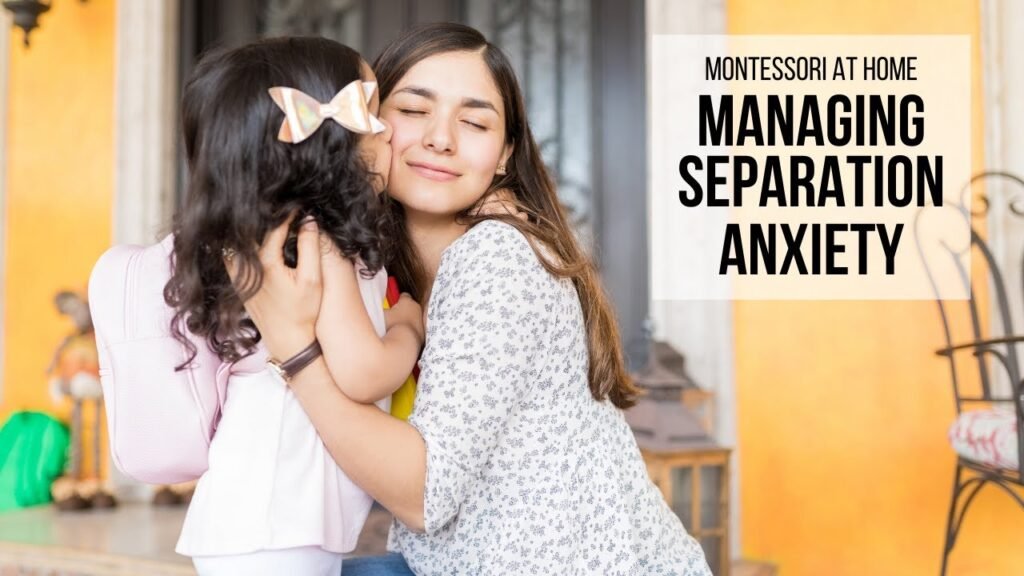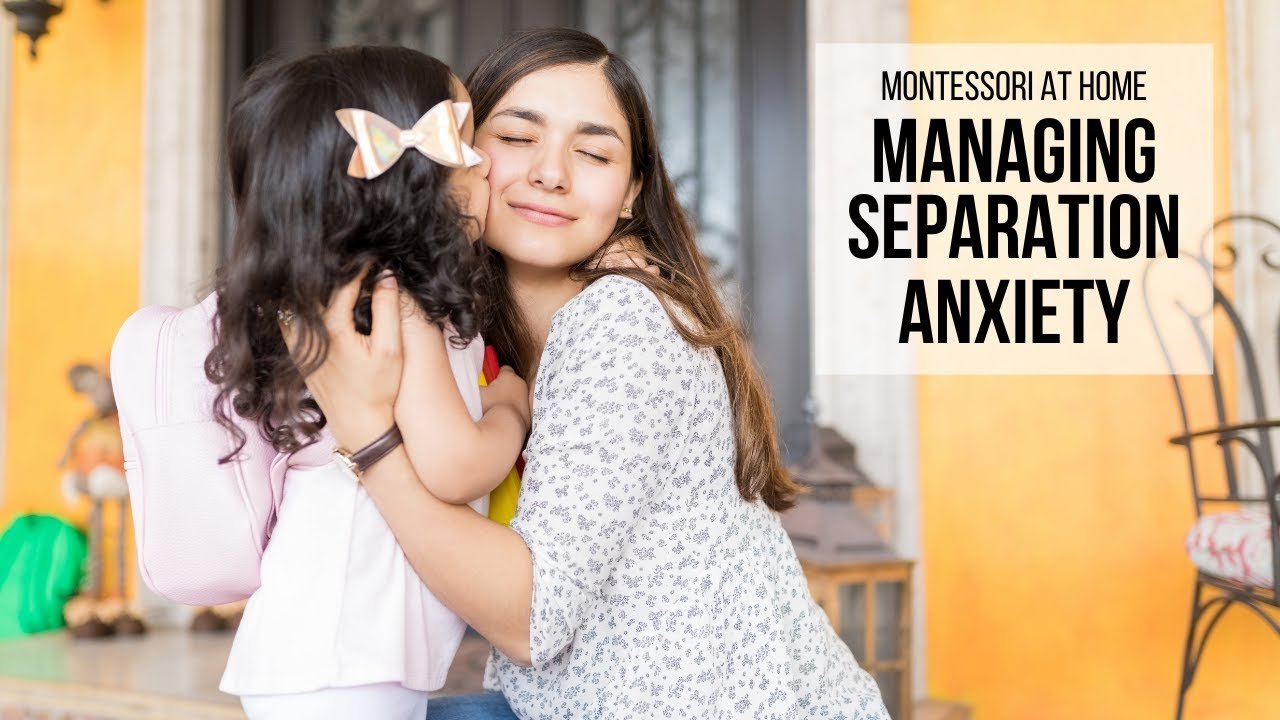Hi there! My name is Ashley, and I’m a mom to two lovely little girls, Kylie and Mia. Today, I want to talk to you about a topic that can be a major source of stress and guilt for many parents – managing separation anxiety in your child. In this video, created by the Hapa Family, we’ll be exploring how to handle separation anxiety using the Montessori method right in the comfort of your own home.
Separation anxiety is completely normal and is a natural part of a child’s development. Parents often struggle with this because it can be challenging to see your child upset and feeling guilty. However, it’s important to exude calm and confidence during separations, and communicate with your child ahead of time to help them mentally and emotionally prepare. By creating a supportive and predictable environment, you can help your child navigate through separation anxiety and develop a sense of security. So, let’s explore practical tips and strategies to respectfully handle separation anxiety and support your child’s growth in a Montessori home setting.

Introduction
Managing separation anxiety in children can be a challenging task for parents. It is natural for children to experience separation anxiety at some point in their development, but it can cause stress and discomfort for both the child and the parent. In this comprehensive article, we will explore what separation anxiety is, why children experience it, and common signs to look out for. We will also discuss the challenges faced by parents and the importance of maintaining calm and confidence throughout the process. Additionally, we will provide practical tips and strategies for preparing children for separations, managing short and longer separations, and applying the Montessori method to help alleviate separation anxiety. By implementing these techniques, parents can create a nurturing and supportive environment for their children during times of separation.
Understanding Separation Anxiety
What is separation anxiety?
Separation anxiety is a normal part of a child’s development and refers to the distress or unease experienced when separated from their primary caregivers, usually their parents. It typically begins in later infancy and can continue through early toddlerhood or even into the preschool years. It is important to understand that separation anxiety is a natural response as children realize they are separate individuals from their parents and may feel scared or unsure when separated from them.
Why do children experience separation anxiety?
Children experience separation anxiety due to their attachment and dependency on their parents or primary caregivers. It is a sign of a healthy attachment and shows that the child feels secure and connected to their caregivers. Separation anxiety often occurs when children reach important developmental milestones, such as becoming more aware of their surroundings or experiencing increased mobility. These milestones can trigger anxiety as they navigate their newfound independence while still relying on their caregivers for security and comfort.
Common signs of separation anxiety
It is essential for parents to be able to recognize the signs of separation anxiety in their children. Some common signs include:
- Crying or distress when separated from the primary caregiver.
- Clinging to the caregiver or refusing to let them leave.
- Fearfulness or anxiety about being left alone, even for short periods.
- Resistance to going to school or daycare.
- Physical symptoms such as stomachaches or headaches.
- Sleep disturbances or nightmares.
- Regression in behavior or development milestones.
By understanding these signs, parents can better address their child’s separation anxiety and provide the necessary support and reassurance.
Challenges Faced by Parents
Guilt and discomfort
Parents often experience feelings of guilt and discomfort when faced with their child’s separation anxiety. It is natural to feel an emotional response when your child is upset or crying, and it can be difficult to leave them in a state of distress. However, giving in to these feelings and avoiding separations can ultimately hinder your child’s development and independence.
Importance of maintaining calm and confidence
It is crucial for parents to maintain a sense of calm and confidence during separations. Children are highly perceptive and can pick up on their parents’ emotions. When parents project calmness and confidence, it helps children feel secure and reassured. It is important to remember that separations are a normal part of life and that you are providing a safe and supportive environment for your child to experience these separations and grow.
Preparing Children for Separations
Open communication with children
Open and honest communication is key when preparing children for separations. Start by engaging in age-appropriate conversations with your child about what will happen during the separation. Use simple language and provide concrete examples or visual aids if necessary. This will help them understand what to expect and reduce any fear or uncertainty they may be feeling.
Explaining the purpose of the separation
Helping children understand the purpose of the separation can also alleviate their anxiety. Explain to them why the separation is necessary, whether it’s for work, school, or other commitments. Emphasize that the separation is temporary and that you will return to them. Assure them that their needs will be met by a trusted caregiver in your absence.
Validating and reassuring their feelings
Validation and reassurance are essential when preparing children for separations. Acknowledge and validate their feelings of sadness, fear, or discomfort. Let them know that it is natural to feel this way and that it is okay to express their emotions. Reassure them that you understand their feelings and that you will always be there for them.
Managing Short Separations
Establish a routine
Establishing a routine can help children feel more secure during short separations. Create a predictable schedule that includes specific times for departures and returns. Having a consistent routine allows children to anticipate and mentally prepare for the separation. This routine can also include enjoyable activities or special rituals before and after the separation to make the experience more positive.
Create a comforting environment
Creating a comforting environment can help ease separation anxiety. Provide familiar and comforting objects or toys that your child can associate with you or home. Incorporate elements of their routine into the environment to help them feel safe and secure. For example, you can leave a note or picture for them to find while you’re away.
Provide transitional objects
Transitional objects, such as a favorite toy or blanket, can provide comfort and reassurance during short separations. These objects act as a substitute for the parent’s presence and can help ease anxiety. Encourage your child to choose a special item to keep with them during the separation and provide comfort when needed.
Managing Longer Separations
Maintain consistent contact
When faced with longer separations, maintaining consistent contact is crucial. Use various communication methods, such as phone calls, video chats, or even handwritten letters or drawings, to stay connected with your child. Regular contact helps reassure them that you are still present and involved in their lives, even though you may be physically apart.
Utilize technology to stay connected
In the digital age, technology provides numerous opportunities to stay connected with your child during longer separations. Use video call applications or messaging platforms to communicate in real-time. Seeing and hearing your voice can provide comfort and lessen the emotional impact of the separation.
Encourage independence and self-reliance
Encouraging independence and self-reliance in your child can help them navigate longer separations more confidently. Teach them age-appropriate skills and activities that they can engage in on their own. Foster a sense of autonomy and resourcefulness, emphasizing that they are capable of handling challenges and situations independently.
The Montessori Method for Separation Anxiety
Overview of the Montessori method
The Montessori method is an educational approach that emphasizes independence, self-directed learning, and respect for the child’s natural development. It can also be applied to managing separation anxiety in children. The Montessori approach recognizes the importance of providing a prepared environment that supports the child’s independence and autonomy.
Applying the Montessori principles at home
Parents can apply Montessori principles at home to help alleviate separation anxiety. Here are some strategies inspired by the Montessori method:
Creating a Prepared Environment
Organize the home environment
An organized and structured home environment can promote a sense of security and familiarity for the child. Arrange their belongings in a logical and consistent manner, ensuring that they can easily access items they need. Having a predictable and clutter-free environment can contribute to a child’s overall sense of well-being.
Provide opportunities for independence
Offering opportunities for independence is a fundamental aspect of the Montessori method and can be particularly helpful in managing separation anxiety. Encourage your child to engage in age-appropriate activities, such as dressing themselves, preparing their own snacks, or tidying up their space. This helps them develop a sense of competence and self-reliance.
Encourage exploration and learning
Montessori principles emphasize the importance of hands-on learning and exploration. Encourage your child to engage in activities that promote learning and discovery. Provide materials and resources that foster their curiosity and allow them to explore their interests independently. This can help distract and redirect their focus during separations.
Practical Life Activities
Benefits of practical life activities
Practical life activities are an essential component of the Montessori curriculum. These activities are designed to develop independence, concentration, and fine motor skills. Engaging your child in practical life activities can help them feel capable and in control, reducing separation anxiety.
Examples of practical life activities for separation anxiety
Some examples of practical life activities that can help alleviate separation anxiety include:
-
Setting the table for meals: Allowing your child to prepare their own place setting can give them a sense of independence and responsibility.
-
Pouring activities: Providing opportunities for your child to pour liquids from one container to another promotes concentration and motor skills.
-
Care of plants or pets: Involving your child in the care of plants or pets can teach them responsibility and empathy, fostering a sense of purpose and accomplishment.
-
Cleaning up toys: Encouraging your child to clean up their toys after playtime not only teaches them responsibility but also helps them develop a sense of order and routine.
By incorporating these practical life activities into your child’s daily routine, you can help them gain confidence and independence, which can contribute to managing separation anxiety.
Conclusion
Managing separation anxiety in children can be overwhelming for parents, but by understanding its nature and implementing strategies to address it, parents can create a supportive environment for their children. Open communication, preparation, and reassurance are key in helping children navigate separations successfully. Applying the Montessori method at home, through creating a prepared environment and engaging in practical life activities, can further aid in alleviating separation anxiety. By employing these techniques, parents can promote their child’s independence, self-reliance, and resilience, ultimately fostering their healthy development and growth.

